What is 411 Length Required Error?
The 411 Length Required Error is a type of HTTP status code.
HTTP status codes are categorized into five distinct classes:
- 100s: These are informational responses.
- 200s: These indicate successful responses.
- 300s: These are redirection codes.
- 400s: These are client-side error codes.
- 500s: These are server-side error codes.
Having understood HTTP status codes, let’s delve into the “411 Length Required” error.
It pops up when the server needs a content-length header, but it’s not provided in the request.
This error usually happens on the client side, which means the request header has an issue.
In a nutshell, the “411 Length Required” error occurs when your request is turned down because it’s missing a content-length header.
If a server needs this detail, you won’t be able to access the site without providing it.
Root Causes of 411 Length Required Error
The main reason for a 411 error is when a client sends a request to a server without specifying the content length in the request headers.
This error might happen when you manually modify request headers or use a tool that doesn’t automatically include the header.
Here are some possible reasons for a 411 HTTP status code error:
- Issues on the Client Side: A client, such as a web browser, API client, or web crawler, sends a request to the server without including the Content-Length. This often happens due to problems in the client application, like a programming mistake or wrong configuration.
- Server-side Configuration: Some servers may be set up to expect a Content-Length header with all requests, even for those where it’s not usually needed, like GET requests. This could be due to specific server settings or security configurations.
- Network Interference: Occasionally, network devices or services, like proxies or firewalls, might disrupt the request, removing the Content-Length header before it gets to the server.
- Content Encoding Issues: If a request is made with certain types of content encoding, such as “chunked” encoding, it might not include a Content-Length header, causing a 411 error. Some servers might not support chunked encoding or might be incorrectly configured to handle it.
- HTTP Version Mismatch: The HTTP/1.1 specification requires the Content-Length header in certain requests, but HTTP/1.0 does not. If a client sends an HTTP/1.1 request to a server only set up to handle HTTP/1.0, it could lead to a 411 error.
How to fix the 411 Length Required Error?
To fix a 411 error, it’s important to figure out why the Content-Length header isn’t included in the request and correct the problem.
To resolve the 411 Length Required error, you need to specify a content length.
Here’s how you can do it:
Solution 1: Verify the URL you requested
When addressing any 400 status codes, it’s advisable to examine the requested URL.
If you input a URL manually to access a website, the address might contain a typo.
To verify if this is the issue, try re-entering the address.
Solution 2: Include a Content-Length Header
If you encounter a “411 Length Required” status code, the most straightforward solution is to include a content-length header.
As the server indicates that the content length is necessary to complete the request, it’s crucial to provide it.
Solution 3: Clear your browser cache and cookies
If the error is caused by corrupted or expired cookies or cache, clearing them could help.
When you clear them, you get new info from the website’s server.
If you use Google Chrome, here’s how to clear its cache:
- Click the three dots in the top-right corner of your window. You can also use the keyboard shortcut (Ctrl + H).
- Go to History History.
- Click on Clear Browsing Data.

- A new window will appear. Choose the Time range, if you wish to erase all data, select All Time.

- Select what you’d like to clear- this could be browsing history, cookies, and other site data, or cached images and files.
- Then, hit the Clear Data button.
Solution 4: Undo Recent Updates
If you’ve recently updated your website or server configurations, consider undoing these updates.
To address this error, you might think about reverting your WordPress website to an earlier version.
This step can assist you in determining if the main software was at odds with other tools on your site.
But remember, it’s crucial to create a backup of your website before you begin this process.
If you skip this step, you could lose significant modifications made with the recent software update.
Once you’ve identified and addressed the issue, you can swiftly return your site to its previous condition.
Solution 5: Remove Extensions
Another method to resolve the “411 Length Required” error is to deactivate browser extensions.
Sometimes, specific add-ons can disrupt your browser, causing it to misinterpret requests.
If you’ve added an extension lately, you might want to think about uninstalling it.
Conclusion
In conclusion, this article has already provided the solutions on how to fix the “411 Length Required” error, which is a type of HTTP status code that occurs when a server requires a content-length header, but it’s not provided in the request.
This error usually happens on the client side, indicating an issue with the request header.
By following the provided solutions above, you can rest assured that you’ll be able to resolve this issue.
For further learning, you can also check the following HTTP status code:


